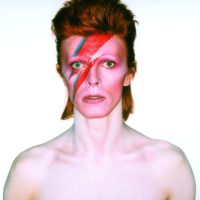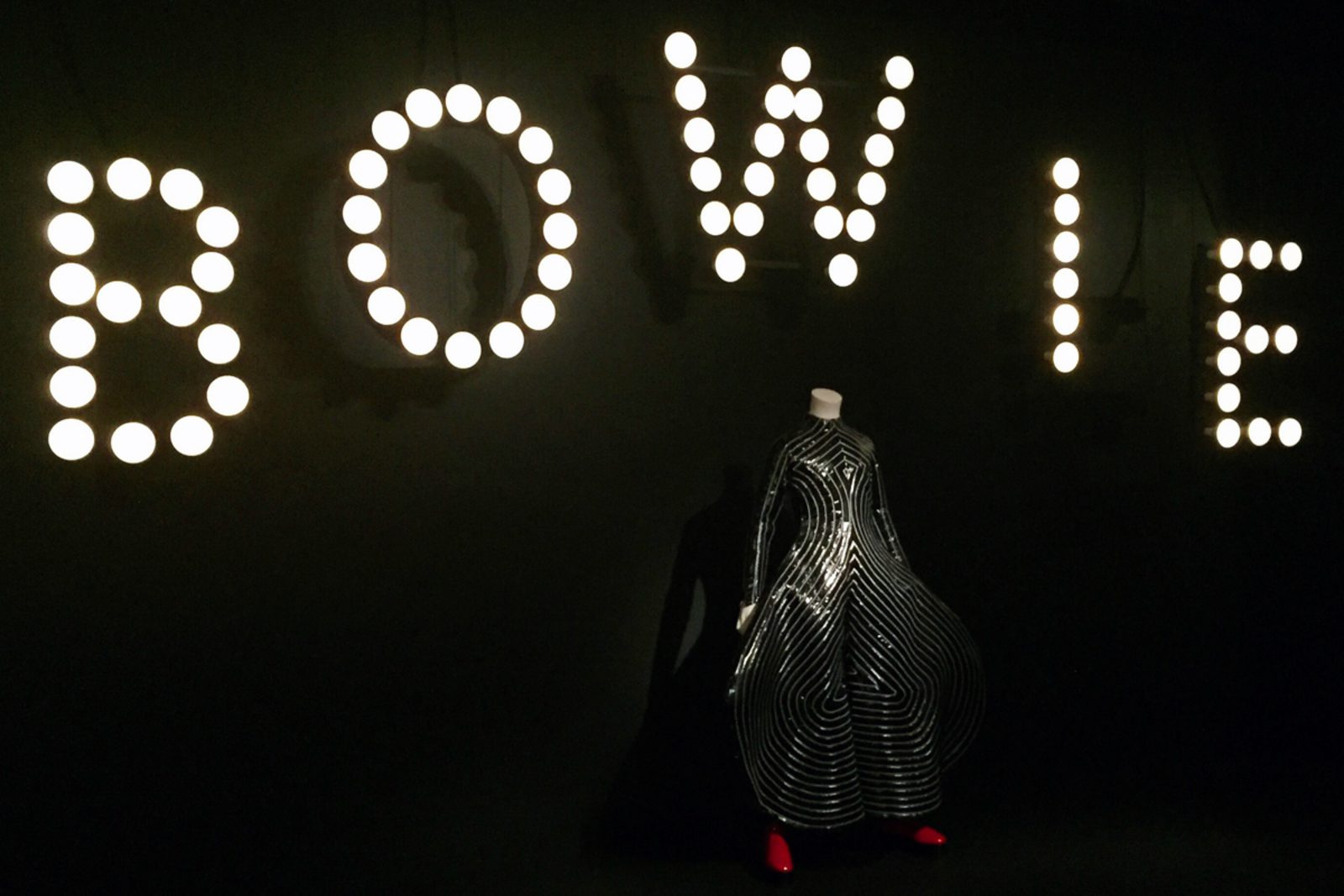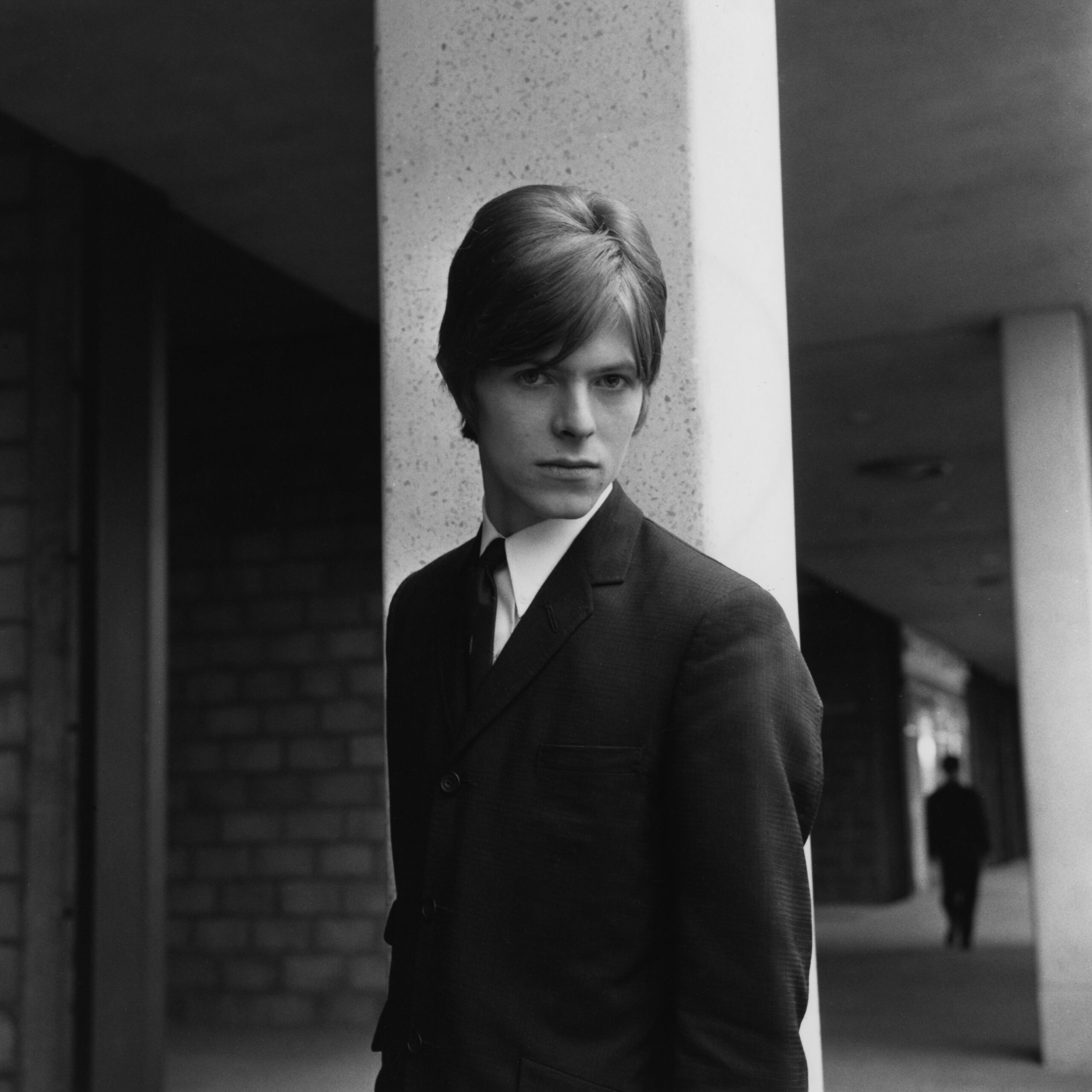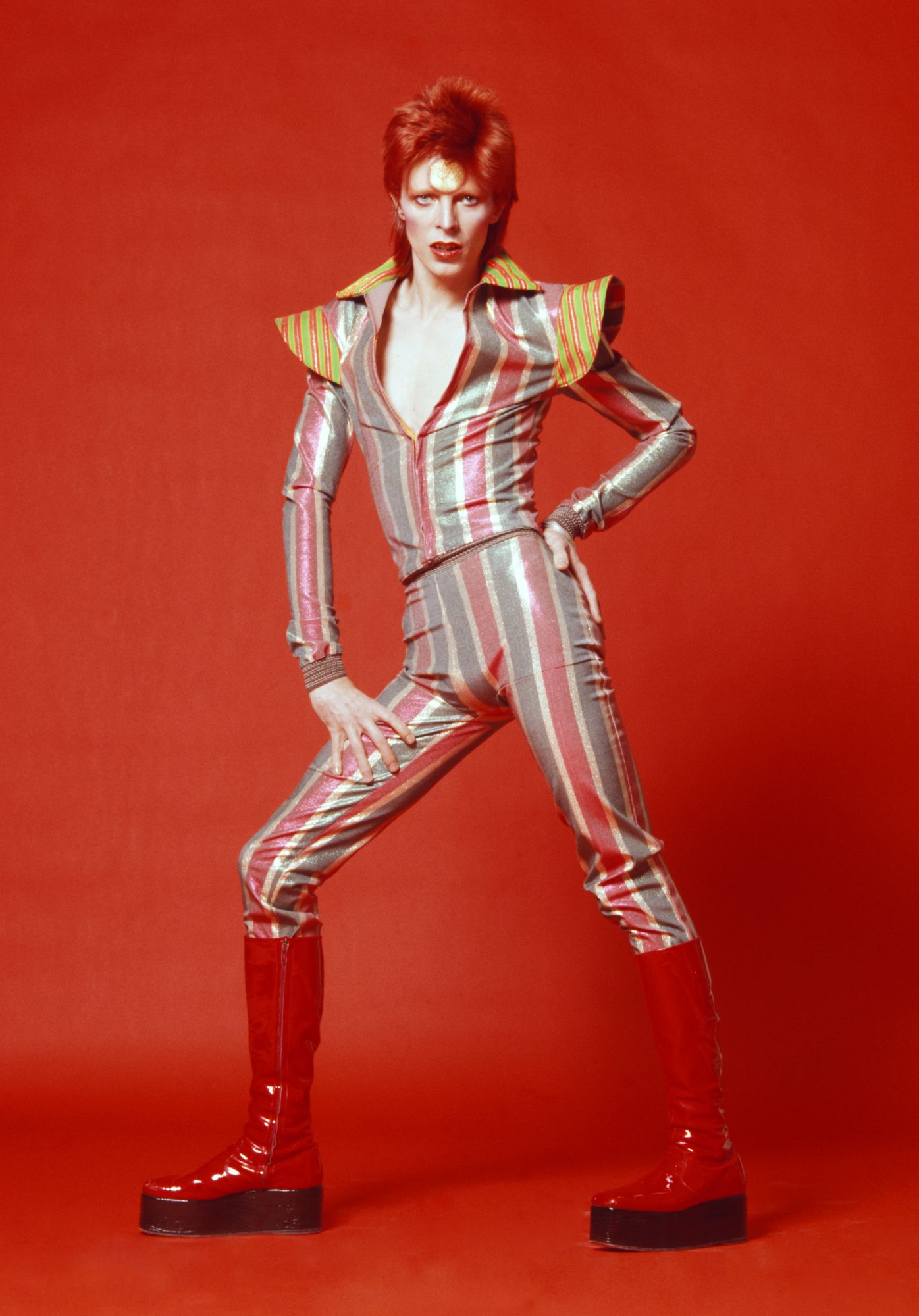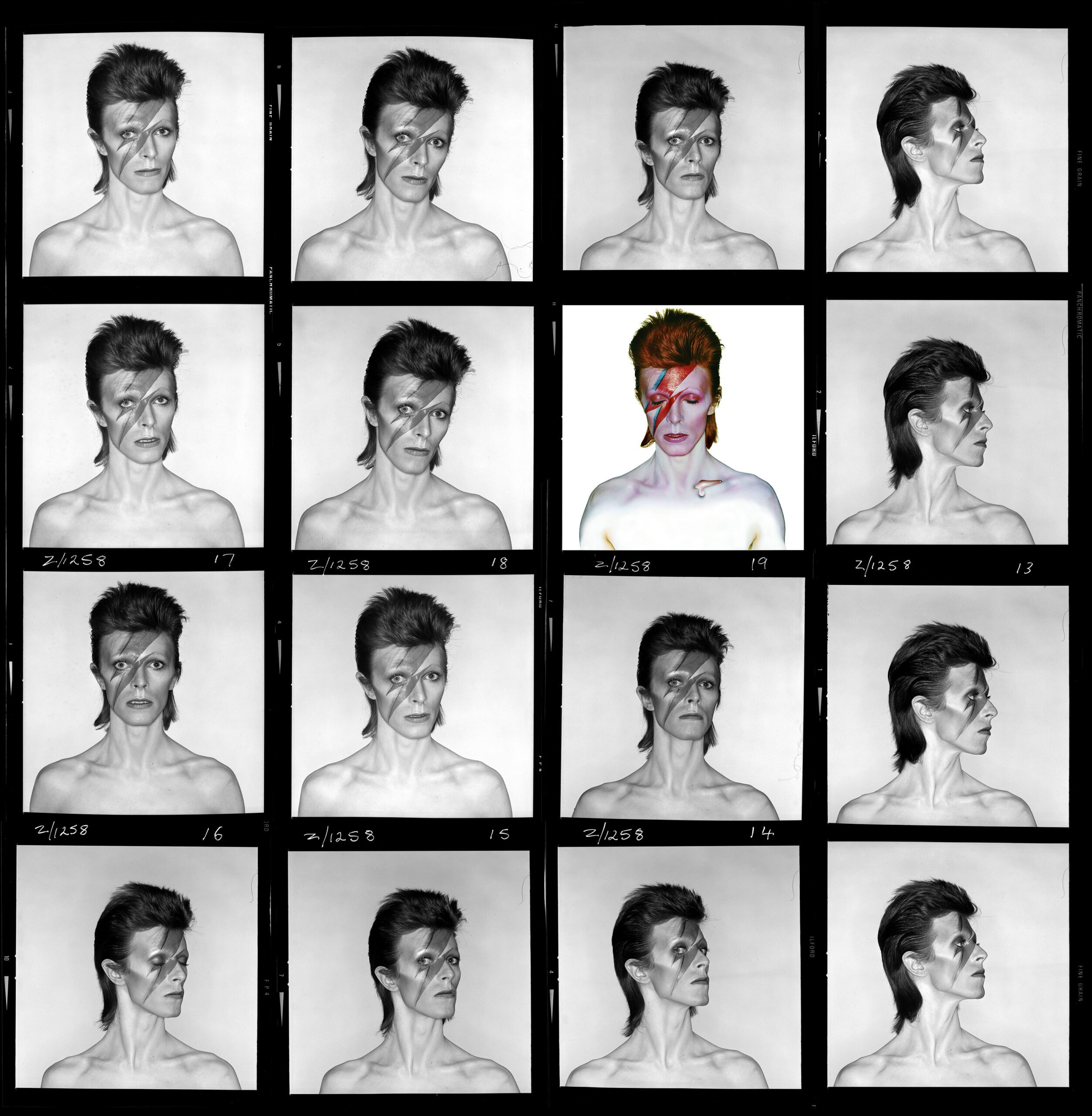Five years ago, “David Bowie is” made its debut in London at the Victoria and Albert Museum. After worldwide stops in Toronto, Sao Paulo, Berlin, Chicago, Paris, Melbourne, Groningen, Bologna, Tokyo, and Barcelona, the exhibition has now reached its final destination, in New York, where it will appear at the Brooklyn Museum until July 15.
Spanning Bowie’s fifty-plus year career, the exhibition is breathtaking, not only in its scope (approximately five hundred objects, including a hundred that have not been exhibited on other stops on the tour), but also in its ability to immerse visitors visually and sonically in Bowie’s world (thanks to audio partner Sennheiser’s special headphones that provide music and commentary timed to one’s travels throughout the exhibition hall).
At the start, visitors are greeted by large flashing lights that spell out Bowie’s name above Kansai Yamamoto’s Kabuki-inspired “Tokyo Pop” patent-leather jumpsuit (1973) —the signage is an artifact from his 2002 pop up shows in New York.
The exhibition is then organized biographically into more than twenty sections, from Bowie’s early years as David Jones through his many creative incarnations.
Aside from the EMS AKS briefcase-sized analog synthesizer that Brian Eno used to create the soundscape for the Berlin trilogy of Low, Heroes, and Lodger, most of the collection is focused on the evolution of Bowie’s visual style. His incredible costumes, in a way, function as a kind of shorthand for his ever-shifting musical identities.
No object is too small or insignificant. Among the more obscure are the keys to the Berlin apartment Bowie once shared with Iggy Pop, a well-wishing telefax sent to him by Elvis, even his 1976 coke spoon. There is also a trove of handwritten lyrics and original art, from oil paintings to doodles drawn on a pack of cigarettes.
But to me, among the most arresting and affecting objects in the exhibition are Bowie’s loose-leafs and notebooks, filled with sketches and ideas, including those for his final album Blackstar, released only two days before his death. Displayed under glass, they stand out as stunning relics, memento mori.
As a life-long Bowie fan, which I’ve chronicled here and here, it was impossible to move through the exhibition without feeling emotionally overwhelmed by the magnitude of Bowie’s life and death, particularly at one point near the end, when I entered into a large darkened room where his video performances were projected onto the walls, as moving film strips, accompanied by surround sound.
It’s not an exaggeration to describe this sensory experience as almost religious—the exhibition invites visitors to contemplate Bowie not as a person, or even a persona, but as an idea, a question without an answer. That’s precisely what makes “David Bowie is” not only retrospective, but also introspective. To ask who or what Bowie “is” is also to ask who or what we are.
From baby boomers who grew up listening to his music to a nine-year old super-fan recently profiled in the New Yorker, everyone has their own Bowie. There was even a “Night of 1,000 Bowies” held as part of this exhibition, which quickly sold out. Perhaps we need several thousand, or even million.
To me, this raises an intriguing question. Bowie was coming out of a career slump when this exhibition first opened at the Victoria and Albert Museum in 2013, and Billboard reports that expectations were low. No other venues had yet booked “David Bowie is” and only 10,000 copies of the exhibition catalogue had been published, but to the Museum’s surprise, more than 300,000 fans turned out for the opening day, and the exhibition went on to be the most attended in its history. Since then “David Bowie is” has already drawn nearly two million global visitors.
Before its arrival in Brooklyn, the exhibition sold tens of thousands of advance tickets. Meanwhile nearby Philadelphia joined in the fanfare with its own “Philly Loves Bowie” week, capitalizing on the fact that Bowie recorded his Young Americans album there in 1975, and kicked off the North American leg of his Glass Spider tour there in 1987. (As part of the festivities a tattoo parlor offered discounted Bowie flash tattoos and a donut shop offered a limited-edition dark chocolate glazed donut glazed with stardust.)
How do we account for this Bowie-mania, which was surely intensified by his death, but preceded it? Aside from his endless capacity for self-invention, Bowie changed the way we experience our own sense of identity. And yet he was still essentially a modernist, voraciously crossing boundaries and borrowing from established genres and cultural references to forge new creative expressions.
My generation, Gen X, inherited this catalogue of musical influences, which came to us via the record labels and the radio. Unable to escape the limits of our shared vocabulary, some of us tried to achieve originality through self-conscious collage or pastiche. Artists including the early Beastie Boys and Beck deployed the extensive and often irreverent use of sampling, and yet others, say Oasis, approached music in a way akin to how a photographer like Sherrie Levine approached canonical artists such as Edward Weston and Walker Evans.
Following the CD era, all of that angst was brought to a halt. The advent of peer-to-peer file sharing hastened the collapse of the music industry, and brought down the machinery that musicians, including Bowie, relied on to sustain their superstardom. But it also did away with the old gatekeeping mechanisms and, more importantly, it killed musical monoculture.
That’s certainly not without its downsides, especially from an economic point of view. But from a creative standpoint, the ubiquity of streaming audio has allowed emerging musicians to access a broader and more eclectic palette, which you might call post-postmodern. As this well-argued piece in The New York Times points out, young artists are not so much resistant to categories as they are oblivious to them.
This is not the end of music, but perhaps the start of many new experimental musical beginnings, shape-shifts, space travels, and all the stuff that makes Bowie an “is…” rather than a was. I’m looking forward to hearing the future.
I started this monthly column, named after one of my favorite Bowie songs, from one of my favorite Bowie albums, in 2014. My goal was to shed light on the creative process, and it has been a sincere honor and pleasure for me to share my conversations and thoughts with you. I feel it’s now time to bring the project to a close, but I hope you will continue to enjoy “Wanted/Needed/Loved: Musicians and The Stuff They Can’t Live Without,” the illustrated series I produce in collaboration with Esme Blegvad. And I hope you’ll also join me as I continue to write broadly about music for The Rumpus. There is still much to come!
***
Photographs appear courtesy of the Brooklyn Museum. Captions and credits in order of appearance:
- Photograph from the album cover shoot for Aladdin Sane, 1973. Photo Duffy c. Duffy Archives & the David Bowie Archive.
- Entrance to the exhibition, courtesy of The Brooklyn Museum
- David Bowie, 1966. Photography by Dough McKenzie. Courtesy of the David Bowie Archive.
- David Bowie, 1973. Photography by Masayoshi Sukita. c. Sukita/The David Bowie Archive.
- Aladdin Sane contact sheet, 1973. Photo Duffy c. Duffy Archive & the David Bowie Archive.
